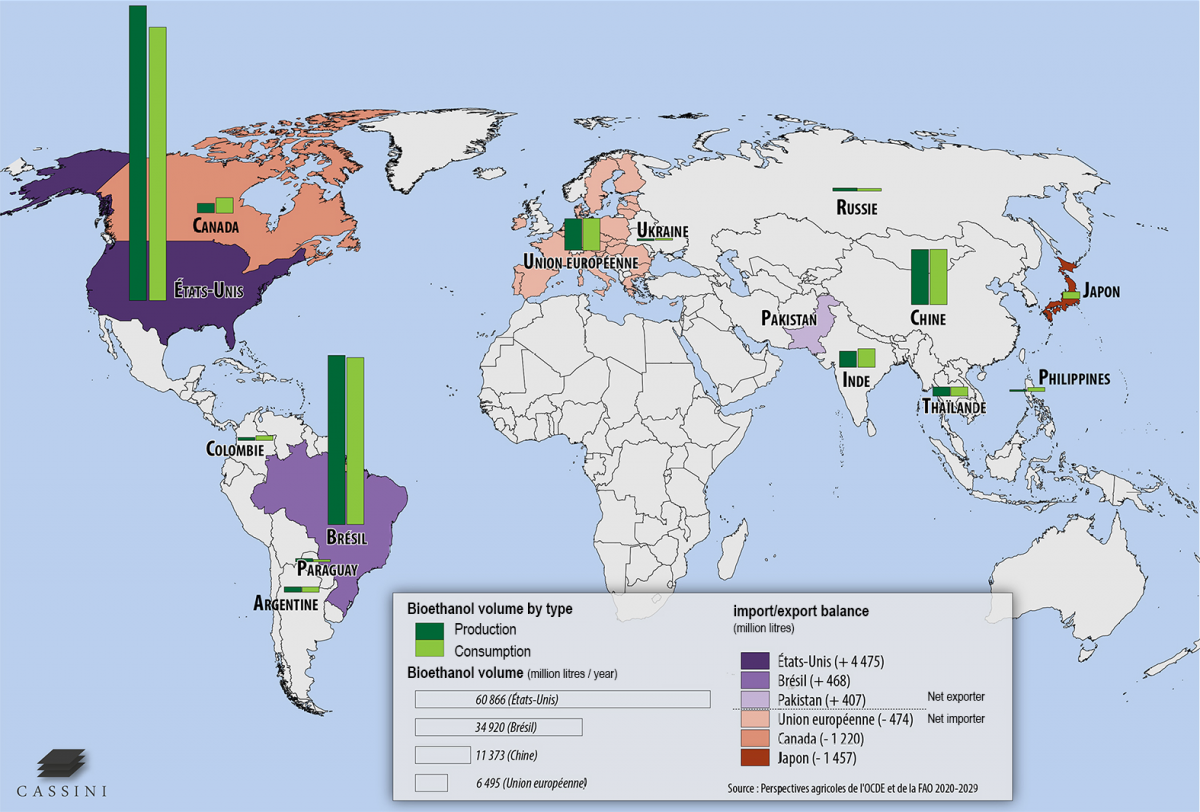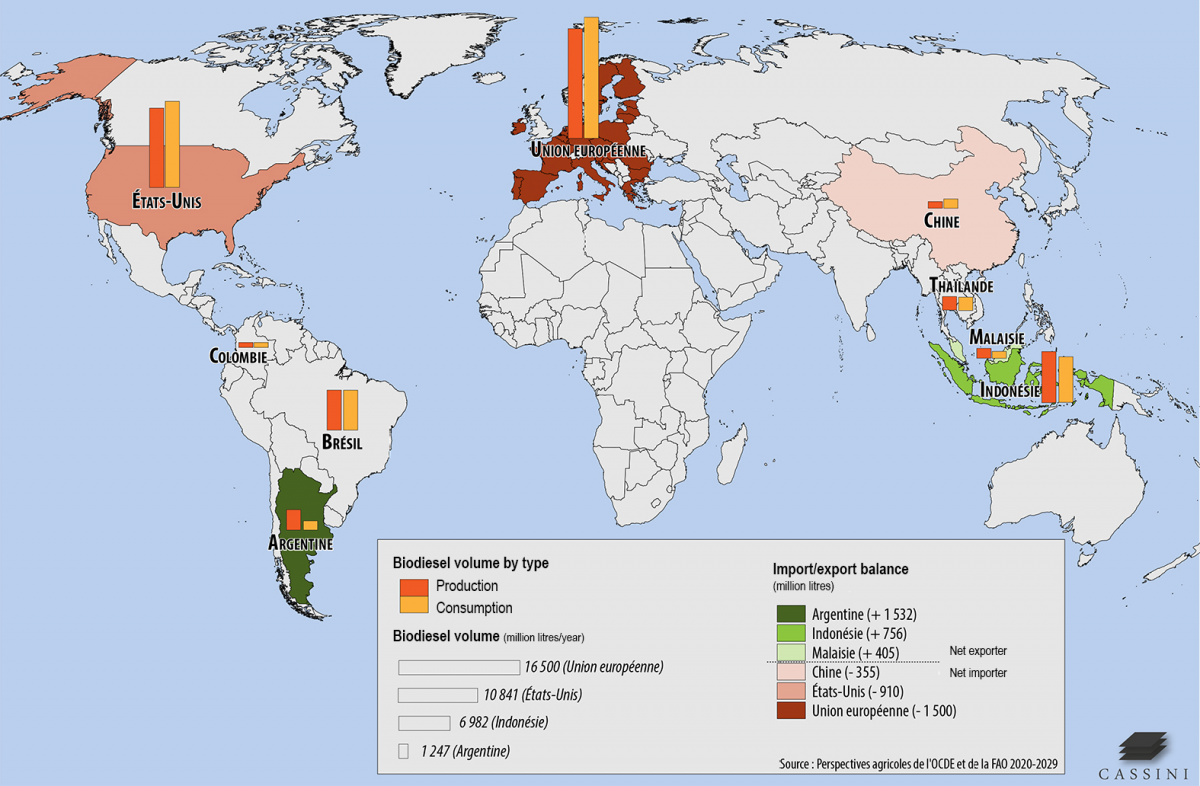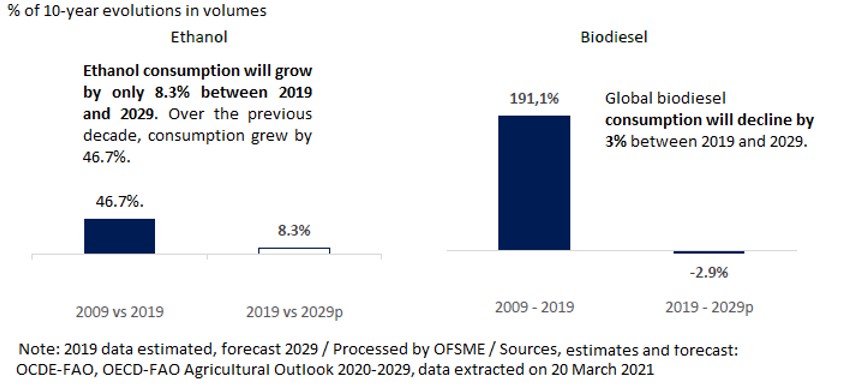Players’ games and land issues
Get this executive brief in pdf format
The growth in global biofuel production has been slowing down since 2010 after a surge in the 2000s and posted its first decrease in 2020. Despite an expected rebound in 2021, the growth in global biofuel consumption could slow down very sharply by 2029, due to a drop in fuel demand, an increased competition between transport technologies and the decarbonisation trend of public policies, especially in the European Union.
This Executive Brief analyses the regional dynamics of the biofuels market, highlighting the main production and consumption zones, and the disruptions and risks to come.
UNDERSTANDING THE BASICS OF BIOFUELS
Biofuels are alternative fuels produced from biomass and used for transportation. There are two major biofuel sectors: bio-gasoline from sugar-based bioethanol and biodiesel from vegetable oils or fatty acid methyl esters (FAME).
Since 2008, European regulations (such as the RED II directive) distinguish conventional biofuels (first generation biofuels from agricultural raw materials that can threaten food security or have a negative impact on land use changes) and advanced biofuels (second and third generation, from non-edible vegetal resources and from micro-organisms such as algae or yeasts, respectively).
Biofuel consumption mainly depends on legal constraints on blending and on the fuel demand trends. They were mainly used in road transport in 2020, but new applications in the maritime and air sector are being developed.
ANALYSIS OF GLOBAL BALANCES UNTIL 2021
A 9-fold increase in global biofuel production between 2000 and 2020
After a surge in the 2000s (+18%/year), the growth in the global biofuel production of biofuels slowed sharply over the 2010-2019 decade (+3.9%/year).
In 2020, global production fell for the first time in 20 years, as the biofuel sector was severely hit by the COVID-19 crisis and related lock-downs and border shutdowns that slashed fuel demand for all transport modes. The decline in global biofuel production was even more severe than that of fossil fuels.
In 2021, production should rebound (+13%), thanks to the expected recovery in oil demand and maintained or strengthened support policies for biomass-based fuels. However, traffic restrictions in the first quarter of 2021 should keep the 2021 production level below its 2019 level.
Figure 1: Global biofuel production (2000-2021)

Source: Global Energy & CO2 data
Conventional biofuels still cover most of global production
Since 2000, the share of biodiesel and hydro treated vegetable oils (HVOs) in total biofuel production has increased nearly 10-fold, from 3.3% in 2000 to nearly 32% in 2020, but bioethanol still accounts for 2/3 of total production.
In 2020, first generation biofuels still covered most of global production, with corn and sugar cane accounting for 64% and 26% of global bioethanol production, respectively, and vegetable oils for 77% of global biodiesel production.
North America and Latin America dominate bioethanol production
In 2019, North America – particularly the United States – was the world's largest ethanol producer with 48% of global production and more than half of global exports. It was followed by Latin America (32%) – mainly Brazil – whose weight in world markets was more limited as a large part of its production is intended for domestic consumption.
Europe was the world's largest producer of biodiesel in 2019 (33%), though it had to import biodiesel to cover its own consumption. Conversely, Asia, the world's second-largest producer of biodiesel (27%), produced more than it consumed and stood as the world's leading exporter of biodiesel in 2019.
Figure 2: Main bioethanol producers and consumers

Source: Cassini
North America and Latin America dominate ethanol consumption, Europe and Asia biodiesel consumption
North America was the world's largest consumer of bioethanol in 2019 (around 45% of the total consumption) but still had a surplus production (equivalent to 2.2% of global ethanol consumption). The region – and mainly the United States – was by far the largest bioethanol exporter worldwide. Latin America, the second largest consumer, had much lower exports, while Asia and Europe relied on imports to cover their bioethanol consumption.
Europe and Asia were the largest consumers of biodiesel in 2019; whereas Europe was the largest importer, Asia was the largest biodiesel exporter, with countries such as Indonesia producing biodiesel from palm oil for export markets, in particular for the EU market.
Overall, international trade in biofuels is relatively low in volume (except for intra-European trade). Exports represented less than 9% of global ethanol production and barely 14% for biodiesel over the period 2017-2019. The share of global biodiesel exports even declined between 2015 and 2019 compared to previous periods since 2000, as most of support measures are aimed at protecting national producers or consist in customs and trade barriers.
Figure 3: Main biodiesel producers and consumers

Source: Cassini
BIOFUEL KEY FIGURES
The United States, leader in global biofuel production (2019)
- #1 in ethanol production (46% of global production) and #2 in biodiesel production (19%).
- 87% of biofuel production is bioethanol (mostly based on corn).
- Strong decline in bioethanol production in 2020 due to transport restrictions, limited decline for bioethanol (anti dumping measures enacted against Argentina and Indonesia).
- Expected recovery to its pre-crisis level by 2022, with slowing domestic petrol demand offset by higher exports to Canada, Brazil or India.
Brazil
- #2 in ethanol production (28%, mainly based on sugar cane) and #4 in biodiesel production (12%, mainly based on soya).
- Expected production growth by 2029, thanks to the RenovaBio plan (since June 2020) that forces fuel suppliers to buy decarbonisation certificates (CBIOs) from biofuel producers.
European Union
- #1 in biodiesel production (over 30% in 2019), and #4 in ethanol production (5%).
- Still dependent on raw material imports (60% dependence) and on biofuel imports (from Argentina, Indonesia, Malaysia and China for biodiesel and from Ukraine, Brazil and the United States for ethanol).
- Expected decline in biodiesel consumption by 2029 (decrease in diesel vehicle sales, improved fuel efficiency and the competition from electric vehicles).
- RED II directive promotes advanced biofuels, which should impact the biofuel production and consumption structure in the EU.
Asia
- China is the world's 3rd largest producer of ethanol (8%) and 8th of biodiesel and HVH (2%).
- Lower demand in 2020 offset by the extension of ethanol blending obligations to new provinces (decided in 2017 to sell out corn stocks)
- The focus on electric mobility could contribute to slowing down the rise in ethanol production by 2029.
- Indonesia is the 3rd largest producer of biodiesel and HVH in 2019, but only the 21st ethanol producer.
- Biodiesel production rise in 2020 due to strengthened biodiesel blending obligation (from 20% to 30%) despite the 12% fall in diesel consumption
- Expected surge in biodiesel consumption by 2029 and fall in exports (EU ban on palm oil-based biodiesel): Indonesia may even become a net biodiesel importer in the coming decade to meet rising demand.
Africa
- 5th largest ethanol producer despite a marginal production (and no biodiesel production) and net ethanol exporter.
- Some countries such as South Africa have introduced support measures but the share of biofuels in road transport in Africa should only average 1.5-2.5% by 2040.
ANTICIPATED RUPTURES AND RISKS BY 2029
Strong slowdown in global biofuel consumption by 2029
Global biofuel consumption could slow down very sharply by 2029, due to several factors, namely a drop in fuel demand, an increased competition between transport technologies and the decarbonisation trend of public policies. Support for public policies will remain one of the pillars of the development of biofuels. However, the EU and the United States are increasingly favouring alternatives to biofuels to decarbonise transports, betting on electric vehicles, hydrogen, and other low-carbon technologies. This should lead to an increased competition from electric mobility, hydrogen, and LNG, while the competitivity of fossil fuels could further dampen prospects for biofuels. Moreover, the COVID-19 crisis could mark a lasting decline in mobility, accelerating the decline in fuel demand due to the decline of thermal cars (especially diesel cars).
Overall, bio-ethanol consumption is expected to increase by 8.3% over the 2019-2029 period, while biodiesel consumption should decline by nearly 3% over this period. The slowdown in consumption should reduce the international trade, especially as the EU plans to stop importing palm oil-based biodiesel and as Indonesia should cut exports to meet its growing domestic demand. Unlike oil, biofuels are expected to remain a commodity produced and consumed locally.
Figure 4: Trends in global biofuel consumption by 2029

Source: OSME from OECD-FAO
Limited share of advanced biofuels in production in 2030
First generation biofuels (mainly from corn, sugar cane and vegetable oils) will continue to dominate global production by 2030, and the share of advanced biofuels should not exceed 10% of world production. Only the EU will show a really high integration rate of advanced biofuels up to 31% of its production, far ahead of China (13%), Indonesia (12%), the United States (8%) or Brazil (6%), thanks to the REDII directive (2018), while Brazil will continue to bet on sugar cane to produce bioethanol.
A new global geography of biofuels
On the supply side, North America will remain the world's leading producer of ethanol, ahead of Latin America. Production will grow strongly in Asia to meet growing energy needs, whereas ethanol production in Europe will decline over the next 10 years, mainly due to the rise of electric vehicles. Europe will remain the largest biodiesel producer in the world, but its production will decline by 10% by 2029. Latin America will become the third largest biodiesel manufacturer in the world, overtaking North America.
On the demand side, North America will remain the world's largest consumer of ethanol. Europe will be the only region whose consumption will not increase over the period, resulting in a slight reduction in its share in global ethanol consumption. In addition, its share in global biodiesel consumption will decline by 2029 (decline of diesel vehicles). Global biodiesel consumption will be driven by developing countries in Asia and in Latin America.
Where ethanol export markets are concerned, the share of North America will decline sharply to the advantage of Latin America (moderate increase in its exports). Exports from Asian countries should decline slightly to meet rising domestic demand. Biodiesel exports from Europe will fall sharply due to the decline in regional production. Exports from Asia will decline by nearly 70% over the same period to meet to the rising consumption, to the advantage of Latin America, which will become the world's leading exporter with biodiesel exports doubling in absolute terms.
Rising climate, social, and environmental risks by 2029
The biofuels' industry will be particularly vulnerable to threats posed by climate change (extreme events and water stress) to the stability of global agricultural supplies. Population growth and reduction in arable land could rekindle the risk of land use conflicts. Finally, debates could arouse over the impacts of biofuel production on forest and biodiversity and its use of synthetic phytosanitary products to maintain its productivity.
Focus on the EU: regulation changes and recovery plan
In the early 2000s, the EU started to promote biofuels, with the triple aim of cutting GHG emissions in transports, improving energy supply security and supporting agricultural production. In 2009, the use of biofuels for transports was supported by the Renewable Energy Directive (RED). Due to criticisms over the impacts of first-generation biofuels (from edible vegetal resources) over agricultural raw materials prices and indirect land use changes (ILUC, i.e., deforestation in Indonesia, Malaysia, and Brazil), a new directive – RED II - was adopted in 2018. It limits the share of first-generation biofuels in transport consumption (up to 7% in 2020) and aims to reduce the share of those with a high ILUC risk as of 2024 to reach 0% by 2030.
The future of the EU biofuel sector is now depending on the measures of the upcoming Green Deal and the Next Generation EU recovery plan, expected in 2021, which will set up the strategy to reach carbon neutrality targets and affect financial resources. However, biofuels remain absent from the EU’s latest strategic choices on transport decarbonation, as the European Commission is supporting the development of a European battery industry and of the European Alliance for Green Hydrogen.
Take aways:
- Global biofuel production increased 9-fold between 2000 and 2020, despite a severe decline in 2020, and should rebound by 13% in 2021 over an expected recovery in oil demand and maintained or strengthened biofuel support policies
- Bioethanol accounts for 2/3 of the global biofuel production and biodiesel for 32%, with first-generation biofuels (corn- and sugarcane-based bioethanol and vegetable-oil based biodiesel) still covering most of global production.
- North America – especially the United States – and Latin America – especially Brazil – dominate bioethanol production and consumption, while Europe and Asia dominate biodiesel production and consumption
- Global biofuel consumption could slow down significantly by 2029, due to the expected drop in fuel demand, an increased competition between transport technologies and the decarbonisation trend of public policies.
- First generation biofuels will continue to dominate global production by 2030, with advanced biofuels limited to 10% (expected share of 31% in the EU thanks to the RED II directive).
- North America will remain the world's leading producer of ethanol, ahead of Latin America, and the largest ethanol consumer, while Europe will remain the largest biodiesel producer despite a lower production by 2029 and a declining share in global biodiesel consumption.
- The biofuels industry will be vulnerable to rising climate, social, and environmental risks by 2029.
This Executive Brief stems from an analysis by Enerdata, the French Institute for International and Strategic Affairs (IRIS) and Cassini for the French Ministry of Defence (full report available in French here).
The Observatory for the Security of Energy Flows and Materials is coordinated by IRIS, a leading French think tank on geopolitical and strategic issues, in consortium with Enerdata and Cassini, under a contract with the Directorate-General for International Relations and Strategy (DGRIS) of the French Ministry of the Armed Forces.
Through quarterly study reports, seminars and cartographic work, the main objective of this observatory is to analyse the energy strategies of three key players: China, the United States and Russia.
 Energy and Climate Databases
Energy and Climate Databases Market Analysis
Market Analysis